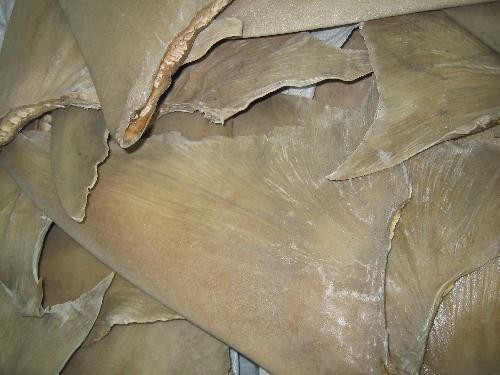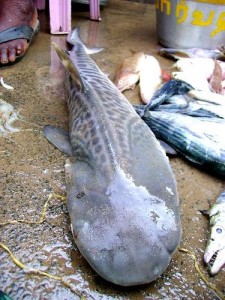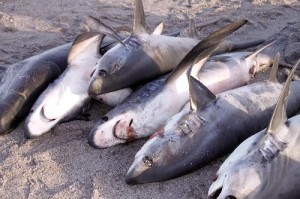 Divya Karnad is a wildlife biologist in India focusing on marine issues. She began her career working with olive ridley sea turtles, studying hatchling responses to beach lighting and temperature-dependent sex determination. Lately, she has been focusing on marine fisheries issues on both coasts of India, including shark fishing and the fin trade. She met WhySharksMatter at the International Marine Conservation Congress, and agreed to write a guest post for Southern Fried Science.
Divya Karnad is a wildlife biologist in India focusing on marine issues. She began her career working with olive ridley sea turtles, studying hatchling responses to beach lighting and temperature-dependent sex determination. Lately, she has been focusing on marine fisheries issues on both coasts of India, including shark fishing and the fin trade. She met WhySharksMatter at the International Marine Conservation Congress, and agreed to write a guest post for Southern Fried Science.
A soupy end to Indian Sharks
Thomas and Arulsingh, fishermen who hail from Kanyakumari, hauled up their nets and fishing lines on a beach in southern India. The catch was special and I was privileged, as an outsider, to be invited to watch as this enormous fish was sliced, its fin, the most valuable part, handled with extreme care. The shark fin, I was told, would fetch a lot of money, despite the fact that it was not a hammerhead, which fetches the best price. Nevertheless, the fishermen revealed, there were several more where this one came from, and they could be caught easily using specialized hooks and lines. Altogether estimated to host about 70 species of shark, 18, including two species of hammerheads, spadenose, requiem and milk sharks, are often landed for fins or meat from Indian waters. Different parts of the Indian coast have different species compositions of sharks, with the northwest reporting large proportions of spadenose sharks, hammerheads along the south west coast, and requiem, hammerheads and milk sharks along the east coast. Sharks are usually brought to shore before finning and the flesh is consumed locally while the fins are exported to South-east Asian markets.

Shark fins reportedly sell for about $ 80 in the wholesale market, which is considered a handsome price as compared to the time and effort spent in catching fish, which are usually sold for a quarter of the price. As the capture of sharks is not banned in India, the practice of finning, which is shunned in several other countries, occurs in broad daylight here. A friend recently reported seeing an autorickshaw (tuk-tuk) stuffed with fins to the point where the driver was hidden from view, on a busy street in the French-influenced town of Pondicherry, south India.
Recognizing the drastic decline in shark numbers, the international community called for a moratorium on their capture and finning. India responded to this situation by introducing a ban on fishing for these elasmobranchs, but due to the vociferous protests from Tamil Nadu fishermen, the then Minister for Environment and Forests, A. Raja who had political roots and aspirations in the state of Tamil Nadu, partially revoked this ban in 2001. Additionally, the Central Marine Fisheries Research Institute, a government body that monitors fishing in Indian waters, recommended that there was scope to increase the exploitation of sharks in Indian waters, despite no existing studies on actual shark populations. Consequently India remains among the top three largest shark fisheries in the world, contributing over 16% of the world’s shark catches.

Tamil Nadu, the most south easterly state in India, remains the stronghold of the traditional shark fishery. More than 90% of the 190 fishermen I spoke to in Southern Tamil Nadu, during a questionnaire survey supported by the Ravi Sankaran Inlaks Fellowship Programme and the National Centre for Biological Sciences, admitted to catching and selling sharks. The fins they sold would reach the final destination, China, through many pathways. Some would pass through Sri Lanka, others through Singapore or Thailand, while still others were sold directly. Eventually many of these fins would land up in Hong Kong. The official estimate of shark landings in India average at about 70,000 tonnes per year. However, this is probably a gross underestimate as the FAO has expressed dissatisfaction with the quality of the data provided by the Indian government and the recent TRAFFIC report on shark trade pegs India at much higher rates of fin trade.
Meanwhile, shark fishing continues unabated. Fishermen who use long-lines in the Lakshadweep don’t always target sharks, but don’t hesitate to use the extra source of income that accompanies their mistaken hooking. A source in the Lakshadweep fishery department revealed that there was a recent shark fin catch weighing several tonnes from a single vessel after a week or so at sea. This means that several thousand shark were killed and discarded or consumed. On the mainland, shark numbers no longer allow for such blatant extermination. The fishermen I spoke to felt that shark numbers, like all the other fish they catch, were on the decline. The reason for this decline was indiscriminate greed, as evinced by another researcher’s observation of a pregnant hammerhead being sold, its stomach slit open to reveal seven dead fetuses.
Despite the grim picture the Central government seems unwilling to take a stand. The ban on shark fishing now covers only ten species of elasmobranchs where some species are not clearly defined. Especially since much of the shark capture occurs in unselective gear such as trawl or gill nets, this ban has not proved effective on field. Further there is no monitoring of the fishery and no accountability on the part of fishermen, who are not forced to report their catches to the government. The Action Forum for Sustainable Shark Fishery which supported the revocation of the ban on shark fishing raises other important points- The government has no idea about how to replenish shark stocks, further there is no concrete data on shark stocks at present. In a country where over 70,000 tonnes of sharks are landed every year (FAO figures) choosing to overlook this industry, which leaves no paper trail and operates on an apparently “small” scale, is a huge mistake.

The situation is only complicated by the fact that unsustainable gear such as trawl nets have only further marginalized artisanal fishermen, who use more selective gears. By losing their fish catch to industrial fishing, these marginalized fishermen are now forced to look at easy ways to earn money, such as by selling shark fins. The root of the problem lies in the fact that it is not clear whether fishing should fall within the purview of the Ministry for Environment and Forests (MoEF) or the Ministry for Agriculture (MoA). While the objective of MoEF is protection, the MoA aims to maximize catch and export of marine products. Similarly while marine species listed as threatened according to Indian laws are protected by the laws pertaining to the MoEF, harvest of unlisted species is controlled (not very strictly) by the MoA. These departments are still not clear about jurisdictions and hence their actions do not co-ordinate well. As the survival of sharks is inextricably linked to the marine world around them, focused species level protection makes no headway. There is no way to save sharks without saving their prey, and there is no way to prevent the fishing of one species while allowing indiscriminating gears to pick off anything that comes in their path.
Writing from Toronto Canada where we have recognised that there is no way to protect sharks by reaching out to fishermen like these in India, we’ve made the call to ban shark fin products.Following hot on the trails of US states Washington,Oregon,Hawaii,Guam and California. If we can reduce the trade, we can reduce the demand.
All over the world sharks are being killed by millions a year ! People just see the money the shark fins brings in, but sharks are much more worth alive than dead (divers travel far distances just to be sure to ezncounter sharks !). But also sharks are top predators in the ocean, they keep the eco system healthy, we need them in our oceans ! So please : Save sharks, don’t kill them ! There must be more substainable ways to earn money ! Think of the future !
Thank you for calling attention to the shark fin trade in India. In Canada and elsewhere in the world, we are calling for a ban on the shark fin trade through education and awareness. I would suggest promoting eco-tourism as this will bring in considerable monies for the longer term.